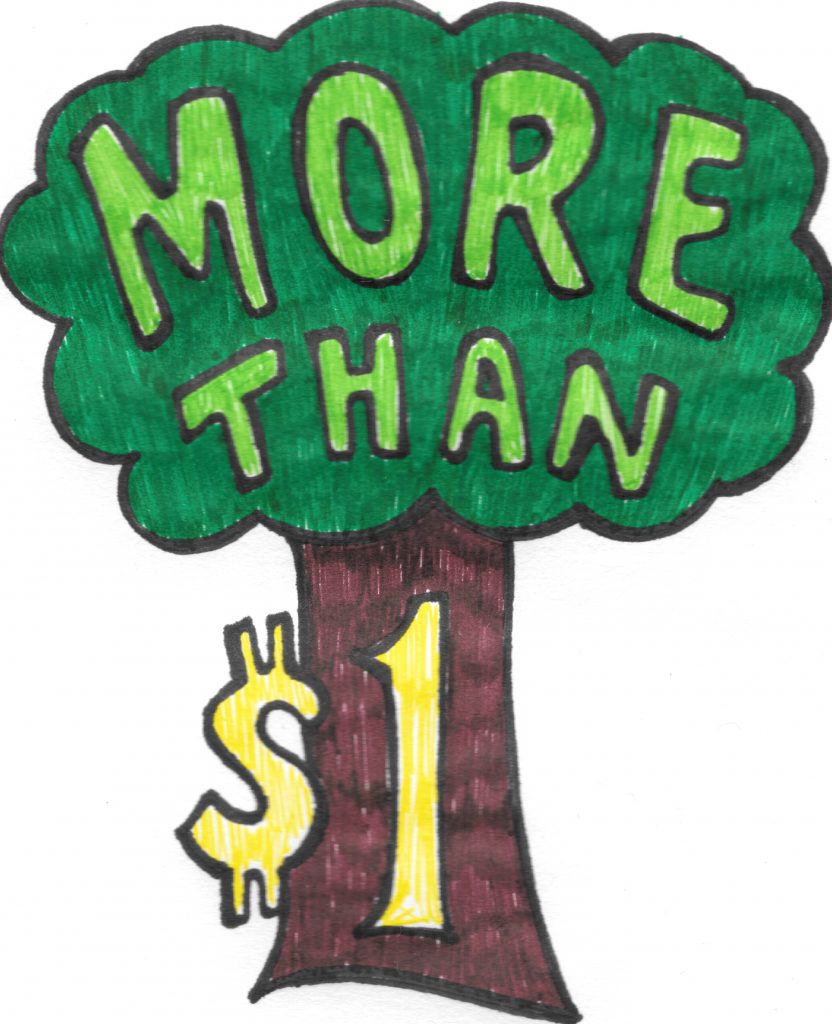There’s something about a “Buck- Twenty-Five Tree” that doesn’t quite have a nice ring to it. Dollar stores first surfaced in America in 1986, with an outfit called “Only $1.00.” Shortly after, a competitor emerged, calling themselves “Everything’s a Dollar.” Following the inevitable lawsuit, they changed their name to “Dollar Tree.” Their business expanded after that. Before long, a plethora of Dollar Tree stores began to sprinkle the American landscape in the mid-90s.
Still, I did not personally encounter such a store till 2004. That was the first year I became homeless. Before that I mostly hung out with upper middle-class white people, teaching music to their children. Dollar stores may have cropped up during my daily itinerary, but if so, I never noticed them. I had bigger bucks on my mind.

In the summer of 2004, having gotten off to a rollicking start in what was to become a long tenure of homelessness, a friend of mine invited me to house-sit for her down in Bakersfield. There, strapped for cash and depressed beyond recognition, I “noticed” a Dollar Tree for the first time.
There was something appealing about walking the aisles of the store. I found affinity with shoppers who were very much like me. We were delighted to see items on sale for only a dollar—stuff that even at Winko’s might have been two or three bucks. I ate up the Dollar Tree. After years of having taken my trips to the local Mollie Stone’s for granted—before crashing down into abject poverty— the Dollar Tree was a godsend.
Even in my present-day mode—no longer homeless but definitely impoverished–I’ve been supplementing monthly trips to Winko’s with smaller, more frequent trips to the Dollar Tree. There’s been something of a joy in being able to eyeball the price tag. Often, I find myself placing 16 items in the cart, not needing to count carefully. At the check stand, I come away just shy of having spent $17 on goodies.
Now that joy is gone. And its absence is twofold.
For one thing, it’s a lot more difficult to guess the cost when I need to multiply the number of items by $1.25. Just haven’t gotten the hang of it yet—it’s no longer easy.
When asked how Dollar Store employees were holding up, a clerk named Sal had this to say.
“Mostly we hear complaints about how hard it’s gotten to tell how much things are going to cost. A lot of the time, people have to go back to the aisles to return items they can’t afford.”
Shaking his head, he continued: “Not happy campers. And neither are we.”
But something else is even less easy. My monthly Dollar Tree budget just got hiked with a 25% increase! While Michael Witynski, the C.E.O. of Dollar Tree, Inc., justifies the increase on the basis of its having “removed constraints that come with the single dollar purchase,” I find this to be a very vague evasion of a somewhat elusive truth. Even inflation cannot account for the price hike. How often has “inflation” taken something up more than 5 or 10 percent at a shot? In my experience, not too often.
“Totally sucks,” said Myrna, an elderly lady in my apartment complex. “I do 3/4 of my shopping at the dollar store. Now I can’t afford common comforts. I’ll be running out of food midway through the month.”
The ultimate truth, when the rubber meets the road, is that this decision is based on greed. Probably Witynski is under pressure from money-guzzling investors. Definitely he’s after the bucks himself.
Michael Witynski made $10,767,883 last year. His employees often make as little as $8.32 per hour. While this inequity may not be in the area of a Jeff Bezos, it’s still telling.
Though I’m still at poverty level, my situation isn’t nearly as dire as it was when I was still outside. When I was still flying a sign on Shattuck Avenue, the Dollar Store was one of my mainstays. In fact, if I did shop for food, I never shopped anywhere else.
How this price hike can possibly be affecting my houseless brothers and sisters in Berkeley, I cannot imagine. Some people have already resorted to theft, even at the Dollar Tree. Partly this was because it was easy. Unsympathetic employees had too much on their sight lines. Sympathetic employees often turned a blind eye.
But largely the theft of basic needs is due to desperation. Desperation, and perhaps a bit of indignation to boot. I sat on that sidewalk watching people of privilege squander money on trivia. How much of that money could be used to feed the hungry?
And now, that desperation, that righteous indignation, has seeped up from the realm of homelessness to that of those who struggle to keep a roof over their heads.
What gets me the most is how all the charm of the Dollar Tree has now died—in one single corporate move. Like I said, there’s something about a “Buck-Twenty-Five Tree” that doesn’t have a very nice ring to it. I think I’ll make a single trip to a crowded Winko’s every month, stock up, and chalk the Dollar Tree up to history.
Andy Pope is a freelance writer who lives in the Pacific Northwest. He is the author of Eden in Babylon, a musical about youth homelessness in urban America.
